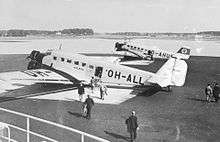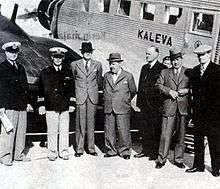Kaleva (airplane)
 Kaleva at Malmi Airport in the late 1930s. | |
| Occurrence | |
|---|---|
| Date | 14 June 1940 |
| Summary | Airliner shootdown |
| Site | near Keri Lighthouse, Gulf of Finland |
| Aircraft type | Junkers Ju 52-3/mge |
| Aircraft name | Kaleva |
| Operator | Aero O/Y |
| Registration | OH-ALL |
| Flight origin | Ülemiste Airport |
| Destination | Helsinki-Malmi Airport |
| Passengers | 7 |
| Crew | 2 |
| Fatalities | 9 (all) |
| Survivors | 0 |
Kaleva was a civilian Junkers Ju 52 passenger and transport plane, belonging to the Finnish carrier Aero O/Y. The aircraft was shot down by two Soviet Ilyushin DB-3 bombers during peacetime between the Soviet Union and Finland on 14 June 1940, while en route from Tallinn to Helsinki, killing all nine on board.[1] The flight number for the route was 1631.[2]
Incident
A few minutes after taking off in Tallinn, Aero Flight 1631 was joined at close range by two Soviet DB-3T torpedo bombers. The bombers opened fire with their machine guns and badly damaged Kaleva, making it crash into the water a few kilometers northeast of Keri Lighthouse. All nine passengers and crew members on board were killed.
Estonian fishermen had witnessed the attack and crash of the plane. Shortly after the crash the Soviet submarine Shch-301 (Щ-301) surfaced and inspected the fishing boats. After confiscating items taken from the wreck by the fishermen, the Soviets picked up diplomatic mail from the wreck and the sea. The future top-scoring Finnish pilot Ilmari Juutilainen was sent to inspect the crash site. After the Soviets spotted the Finnish airplane, the submarine hid its flag.
At the time of the incident Finland was not at war with the Soviet Union. The attack was probably part of the Soviet preparations for the full-scale occupation of Estonia, which took place two days after the Kaleva incident, on 16 June 1940. The occupation was preceded for several days by a Soviet air and naval blockade, which included preventing diplomatic mail from being sent abroad from Estonia. The passengers on the last flight of Kaleva included two German businessmen, two French embassy couriers, one Swede, an American courier, and an Estonian woman. The French couriers had over 120 kilograms of diplomatic mail in the plane. The American courier was reportedly transporting the U.S. military codes to safety from Estonia.[3][4]
The government of Finland did not send any complaints or questions to the Soviets out of fear of hostile Soviet response, and the true reason for the crash was hidden from the public. This was due to the heavy pressure put upon Finland during the Interim Peace by the Soviets. After the outbreak of the Continuation War, the incident was described in detail by the government.
G. Golderg's report

The commander of Shch-301 G. Golderg's report on the incident held in the Russian State Naval Archives starts with the notice of a Finnish airplane on its way from Tallinn to Helsinki on 14 June 1940 at 15.05 PM. According to the report, the airplane was chased by two Soviet Tupolev SB high-speed bombers. At 15.06 PM, the Finnish airplane caught fire and fell into the sea, 5.8 miles from the submarine. At 15.09 PM the submarine took course to the crash site and made it to the location by 15.47 PM. The submarine was met by three Estonian fishing boats near the detritus of the airplane. The Estonian fishermen were searched by lieutenants Aladzhanov, Krainov and Shevtshenko. All valuables found from the fishermen and in the sea were brought on board of the submarine: the items included about 100 kg of diplomatic post, valuables and foreign currencies. At 15.58 a Finnish fighter plane was noticed with the course towards the submarine. The airplane made three circles above the site and then flew towards Helsinki. The exact coordinates of the crash site were determined to be at 59°47′1″N 25°01′6″E / 59.78361°N 25.01833°E.[5]
A. Matvejev's report
Captain A. Matvejev's report states that on board the Shch-301 noticed an airplane crash on 14 June 1940 at 15.06 on 5.8 miles distance from the submarine. At the crash site three Estonian fishing boats and the remains of the airplane were found. At 15.58 PM a Finnish fighter plane made three circles above the crash site. By 16.10 PM all items found from the sea and from the hands of the fishermen were brought on board the submarine. The items included about 100 kg of diplomatic mail, and valuables and currencies including: 1) Two golden medals, 2) 2000 Finnish marks, 3) 10.000 Romanian leus, 4)13.500 French francs, 5) 100 Yugoslav dinars, 6) 90 Italian liras, 7) 75 US dollars, 8) 521 Soviet rubles, 9) 10 Estonian kroons. All items were put on board of patrol boat Sneg and sent to Kronstadt.[6]
Victims
| Nationality | Passengers | Crew |
|---|---|---|
| 2 | ||
| 2 | ||
| 2 | ||
| 1 | ||
| 1 | ||
| 1 | ||
| Total | 7 | 2 |
The plane was piloted by Captain Bo von Willebrand, and Tauno Launis was the wireless operator. The American victim was Henry W. Antheil Jr., younger brother of noted composer George Antheil. Antheil worked as a clerk at the U.S. Legation in Helsinki. In 2007, he was honored for his service in a ceremony at the U.S. Department of State. His name was inscribed on the U.S. Department of State's Wall of Honor.[7]
- Bo Hermansson von Willebrand (captain)
- Tauno Launis (co-pilot)
- Henry W. Antheil Jr. (American diplomat)
- Frederic Marty (French diplomatic courier)
- Paul Longuet (French diplomatic courier)
- Rudolf Cöllen (Germany)
- Friedrich-Wilhelm Offermann (Germany)
- Max Hettinger (Sweden)
- Gunvor Maria Luts (Finnish-born Estonian citizen)
In popular culture
The shootdown of Kaleva is a central event in the novel trilogy Litsid (The Whores, 2015-2018) by Mart Sander and in the TV series by the same name (2018).[8] The book follows the theory proposing that Henry Antheil (played in the series by Matt Fien) was tasked with transporting the last remaining gold from the Estonian gold depository (11 bars) to Finland, only days before the Soviet occupation begun. There were 227 kilograms of diplomatic luggage on the plane.[9] Another theory suggests that the orders came straight from Stalin, who was convinced that Estonian president Konstantin Päts is trying to flee the country on it.[10]
See also
Notes
- ↑ Virtualpilots - Tapauskaleva. Retrieved on 30-1-2007.
- ↑ Niku, Risto (2007). Kalevan kuolemanlento (in Finnish). Jyväskylä: Edita. p. 11. ISBN 978-951-37-4965-1.
- ↑ FoMa - The wreck of Kaleva possibly found. Retrieved 30-1-2007.
- ↑ The Last Flight from Tallinn Archived 2009-03-25 at the Wayback Machine. at American Foreign Service Association
- ↑ Pavel Petrov, p. 168
- ↑ Pavel Petrov, p. 167
- ↑ Henry W. Antheil Archived 2010-05-27 at the Wayback Machine. Retrieved 18 March 2009.
- ↑ Litsid: The Whores on IMDB
- ↑ Vahter, Tarmo (October 11, 2007). "67 aasta tagune õhumõrv lahendatud" (in Estonian). Eesti Ekspress. Retrieved 31 May 2018.
- ↑ Vahter, Tarmo (25 June 2015). "Stalin käskis Pätsi tappa! Tuntud Soome ajaloolase versioon" (in Estonian). Eesti Ekspress. Retrieved 31 May 2018.
References
- Petrov, Pavel (2008). Punalipuline Balti Laevastik ja Eesti 1939–1941 (in Estonian). Tänapäev. ISBN 978-9985-62-631-3.
- Gummerus, Vuosisatamme kronikka, p. 543. 1987. ISBN 951-20-2893-X